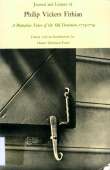You are here
قراءة كتاب Journal and Letters of Philip Vickers Fithian: A Plantation Tutor of the Old Dominion, 1773-1774.
تنويه: تعرض هنا نبذة من اول ١٠ صفحات فقط من الكتاب الالكتروني، لقراءة الكتاب كاملا اضغط على الزر “اشتر الآن"

Journal and Letters of Philip Vickers Fithian: A Plantation Tutor of the Old Dominion, 1773-1774.
Transcriber's note:
Archaic spelling and variations in spelling, punctuation and hyphenation have been retained except for those listed at the end of the book.
Journal & Letters of
Philip Vickers Fithian
1773-1774:
A Plantation Tutor of the
Old Dominion

EDITED, WITH AN INTRODUCTION, BY
HUNTER DICKINSON FARISH;
ILLUSTRATED BY FRITZ KREDEL
The University Press of Virginia
Charlottesville
COPYRIGHT 1957 BY COLONIAL WILLIAMSBURG, INCORPORATED
Previous editions copyright 1943, 1945
by Colonial Williamsburg, Incorporated
ALL RIGHTS RESERVED
Library of Congress Catalogue Card Number 57-13498
The University Press of Virginia
First printing for Dominion Books
October 1968
Fourth printing 1990
Printed in the United States of America
Preface
Once in a great while historians find a firsthand account that provides striking insight into a past era. Only rarely is such a document written with the perception and charm that make its readers feel as if they had participated in the incidents described and shared the experiences related. The journal and relevant correspondence of Philip Fithian constitute this kind of source.
Fithian was reared in New Jersey and attended the College of New Jersey in Princeton, receiving his degree in 1772. Before entering the Presbyterian ministry, he followed the advice of President Witherspoon of Princeton and became a tutor in the family of Robert Carter at "Nomini Hall" plantation on the Northern Neck of Virginia. The reactions of the somewhat austere young man to the rich, warm life of a Virginia plantation are always instructive and often amusing. The Carters and their seven children were a fascinating family, liberal in their sentiments and deeply interested in books and music. Fithian sets forth truthfully, yet with lively touches, the family's assessments of the society in which it moved, the institution of slavery, and the dispute developing with the mother country. Throughout his experiences Fithian remained true to his "fair Laura"—Elizabeth Beatty in far off New Jersey.
The journal, with certain of the letters, was first published in 1900, in somewhat abbreviated form, by the Princeton Historical Association. Dr. Hunter Dickinson Farish, in his edition of The Journal and Letters of Philip Vickers Fithian (Williamsburg Restoration Historical Studies, III; Williamsburg, Va., 1943), included the complete journal, added other relevant letters as well as Fithian's catalogue of Carter's library, and supplied a thoughtful Introduction.
Dr. Farish was Director of Research at Colonial Williamsburg from 1937 until ill health forced him to retire in 1944. He broadened the program there by bringing young research associates to the staff, making grants-in-aid to scholars in the field of early American history, and establishing and editing the Williamsburg Restoration Historical Series. He also taught at the College of William and Mary and helped to work out the organizational plans for the Institute of Early American History and Culture, which since 1943 has been jointly sponsored by Colonial Williamsburg and the College of William and Mary.
Dr. Farish's edition of the Journal had been out of print for a few years when, in 1957, Colonial Williamsburg reissued it, with pen and ink illustrations by Fritz Kredel designed to interest new readers. The present edition by the University Press of Virginia reproduces the 1957 one, but in convenient paperback form. Young Fithian's revealing picture of Virginia plantation life will always be a key source for the historian and an absorbing human document for the general reader.
Edward P. Alexander
Director of Interpretation
Colonial Williamsburg
September 1967
Contents
| INTRODUCTION | |
| 1. Virginia During the Golden Age | xiii |
| 2. Philip Fithian and the Carter Family | xxv |
| JOURNAL AND LETTERS OF PHILIP FITHIAN | 3 |
| APPENDIX | 221 |
| NOTES | 237 |
| INDEX | 249 |
CHAPTER ONE
Virginia During The Golden Age
In the "Golden Age," or half-century immediately preceding the American Revolution, a remarkable civilization reached its zenith in the broad coastal plain of eastern Virginia. Gradually, during a century of colonization and expansion, the heavily wooded tidewater had been converted into a land of settled order and accumulated wealth. Vast estates had been carved out of the wilderness and large plantations were everywhere the rule.
Embraced by numerous arms of the Chesapeake and covered by a network of wide rivers and creeks, this sylvan Venice abounded in safe and convenient water routes. Pressing through the mouths of the deep estuaries, the ocean tides reached the "fall-line," beyond which the streams were inaccessible to shipping owing to the rapids. Ocean vessels could penetrate to the plantations in every part of the lowlands and carry cargoes thence straight to the wharves of London and the outports. Despite the distance and rigors of the voyage, the colonists of the Tidewater had maintained a constant intercourse with the mother country from the time of their earliest settlement.
The hope had long persisted that this coastal plain might yield the ores, timber, ship stores and other products England needed, and for which she then largely depended on foreign potentates. Lacking an ample supply of cheap labor, however, colonial industries could not compete with well-established ones of the Old World. For well over a century tobacco proved the one commodity which the colony could profitably produce for the home market in large quantities.
A notable result of the method of tobacco


